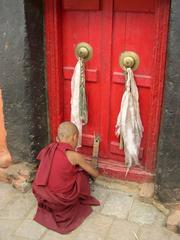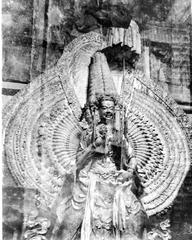Zorawar Fort Leh: Visiting Hours, Tickets, and Historical Significance
Date: 14/06/2025
Introduction: Discovering Zorawar Fort’s Legacy
Perched on a strategic hillock overlooking Leh in Ladakh, India, Zorawar Fort is an enduring symbol of the Dogra dynasty’s military acumen and Ladakh’s integration into wider Himalayan geopolitics. Constructed between 1836 and 1841 under General Zorawar Singh Kahluria—often called the “Napoleon of India”—the fort not only served as a military bastion and administrative hub but also as a linchpin in controlling historic trade routes. Today, Zorawar Fort is a preserved heritage site and museum, offering visitors a vivid window into 19th-century Himalayan history and culture (Leh District Administration, Republic World, The Tribune India, Incredible India).
This comprehensive guide provides essential information for planning your visit—covering the fort’s history, architecture, visiting hours, ticketing, accessibility, and nearby attractions.
Table of Contents
- Introduction
- Origins and Construction
- General Zorawar Singh: The Napoleon of India
- Strategic Importance in the Dogra-Tibetan Wars
- Architectural Features and Defensive Design
- Administrative and Trade Roles
- Modern Preservation and Museum
- Cultural Symbolism
- Visiting Hours and Ticket Information
- Accessibility and Travel Tips
- Nearby Attractions and Suggested Itineraries
- Recommended Photography Spots
- Visitor FAQ
- Conclusion and Final Tips
- References
Origins and Construction of Zorawar Fort
Zorawar Fort, also referred to as Riasi Fort, was established during the pinnacle of Dogra expansion into Ladakh. Built with robust stone and sun-dried mud bricks sourced locally, the fort’s thick, high ramparts were designed to withstand both the elements and artillery. Its hilltop location provided sweeping views of the Indus River and Leh, ensuring both defensive strength and the ability to monitor movement along vital trade and military routes (Leh District Administration).
General Zorawar Singh: The Architect of Himalayan Expansion
General Zorawar Singh Kahluria (1786–1841), serving under Maharaja Gulab Singh, led transformative military campaigns that brought Ladakh, Baltistan, and parts of western Tibet under Dogra control. Operating from his Leh headquarters, Zorawar Singh’s military ingenuity and daring expeditions earned him the moniker “Napoleon of India” (The Tribune India). His legacy is enshrined in the fort’s museum, which displays personal artefacts, maps, and weapons from his campaigns.
Strategic Importance During the Dogra-Tibetan Wars
Zorawar Fort’s significance peaked during the Dogra-Tibetan Wars of the 1840s. It was from this fortified base that General Zorawar Singh launched his 1841 campaign into Tibet. Although initially successful, the Dogra forces faced setbacks due to harsh winter conditions and fierce resistance, culminating in General Zorawar Singh’s death near Taklakot (Live History India). Despite this, the fort remained a crucial outpost for administration and defense.
Architectural Features and Defensive Design
Zorawar Fort’s design is a blend of Dogra, Ladakhi, and Central Asian styles. Its rectangular layout includes:
- High ramparts and four bastions for surveillance and defense.
- Fortified main gate with heavy timber and iron spikes to thwart battering rams.
- Barracks, armories, storage rooms, and a central courtyard for assemblies and parades.
- Loopholes for muskets and cannons.
- Local construction materials—sun-dried bricks, stone, clay, and wooden beams—provide both stability and insulation (Incredible India, Tourism of India, Cliffhangers India).
The fort’s architecture has allowed it to withstand Ladakh’s harsh climate and the passage of time.
Administrative and Trade Roles
Beyond its military function, Zorawar Fort served as the Dogra governor’s residence and administrative headquarters. It oversaw the collection of taxes and regulated trade along the Silk Route, with Leh serving as a major hub for goods such as pashmina wool, salt, and tea. The fort’s security promoted economic growth and integration of Ladakh within the Dogra state (Ladakh Tourism).
Modern Preservation and Museum
After the decline of Dogra power and India’s independence, the fort’s military role diminished. Restoration efforts led by the Indian Army in 2006 stabilized the structure and established a museum featuring weapons, coins, campaign maps, and personal effects of Dogra leaders (Outlook Traveller, Wikipedia, WanderOn). Occasional sound and light shows and cultural events are held during peak tourist seasons.
Cultural Symbolism
The fort is a site of memory and pride for both Dogra descendants and Ladakhi locals. Annual commemorations honor General Zorawar Singh and his soldiers, and the fort’s presence is a reminder of Ladakh’s dynamic history and cultural diversity (The Print).
Visiting Hours and Ticket Information
- Opening Hours: Daily, 9:00 AM to 5:00 PM.
- Tickets:
- Indian Nationals: INR 20
- Foreign Nationals: INR 100
- Children under 12: Free
(Ticket prices may vary; check locally for updates.)
Tickets are available at the entrance. Group bookings and guided tours can be arranged through the Leh tourism office (Triphobo, Wanderlog).
Accessibility and Practical Travel Tips
- Location: About 2 km from Leh main market; accessible by car, taxi, or a short uphill walk.
- Mobility: The approach includes a moderately steep, uneven path; wheelchair access is limited.
- Facilities: Basic restrooms; no on-site food outlets—Leh market nearby offers various dining options.
- Travel Tips:
- Wear comfortable shoes and layered clothing.
- Carry water and sun protection.
- Visit in the morning for fewer crowds and cooler temperatures.
- Best Season: May–September offers mild weather; winter visits are challenging due to snow (Wanderlog).
Nearby Attractions and Suggested Itineraries
Enhance your visit by exploring these nearby landmarks:
- Leh Palace: 17th-century royal palace with panoramic views.
- Shanti Stupa: Buddhist monument and sunset viewpoint.
- Namgyal Tsemo Monastery: Renowned for murals and relics.
- Hemis Monastery: Major Buddhist site, 45 km from Leh.
Itineraries combining Zorawar Fort with these attractions are available online (Triphobo).
Recommended Photography Spots
The fort’s bastions and ramparts offer sweeping views of Leh, the Indus Valley, and the mountains. Sunrise and sunset provide dramatic light for landscape photography. Respect signage about photography, especially near religious spaces.
Visitor FAQ
Q: What are Zorawar Fort’s visiting hours?
A: Daily, 9:00 AM–5:00 PM.
Q: How can I buy tickets?
A: Purchase at the entrance; no online booking currently available.
Q: Is the fort accessible for differently-abled visitors?
A: Accessibility is limited due to uneven terrain and steps.
Q: Are guided tours available?
A: Yes, local guides offer tours for a fee.
Q: Are food and restrooms available on-site?
A: Basic restrooms are available; food is not, but options are nearby in Leh market.
Q: Is photography allowed?
A: Yes, except in restricted museum or religious areas.
Conclusion and Final Tips
Zorawar Fort stands as a living testament to Ladakh’s multifaceted history, Dogra military strategy, and cultural diversity. Its robust architecture, panoramic views, and rich museum collections make it a must-visit for history enthusiasts, cultural explorers, and travelers alike. To maximize your visit:
- Arrive early for the best light and fewer crowds.
- Pair your trip with nearby attractions for a comprehensive Leh experience.
- Acclimatize to Leh’s altitude before undertaking physical activity.
- Download the Audiala app or follow our channels for real-time updates and travel inspiration.
For the most current information, consult official tourism sources and local guides.
References
- Leh District Administration
- The Tribune India
- Live History India
- Incredible India
- Ladakh Tourism
- Outlook Traveller
- The Print
- Thrillophilia
- Tourism of India
- Capture a Trip
- Cliffhangers India
- Ladakh Travel Now
- Wikipedia
- WanderOn
- Republic World
- Triphobo
- Wanderlog
Image suggestions:
- “Zorawar Fort: Hilltop view of Leh town, Ladakh”
- “Dogra dynasty weapons display at Zorawar Fort museum”
- “Sunset from Zorawar Fort overlooking the Indus Valley”
- “Map of Zorawar Fort in relation to Leh’s attractions”

